2015 NISSAN LEAF seats
[x] Cancel search: seatsPage 125 of 412
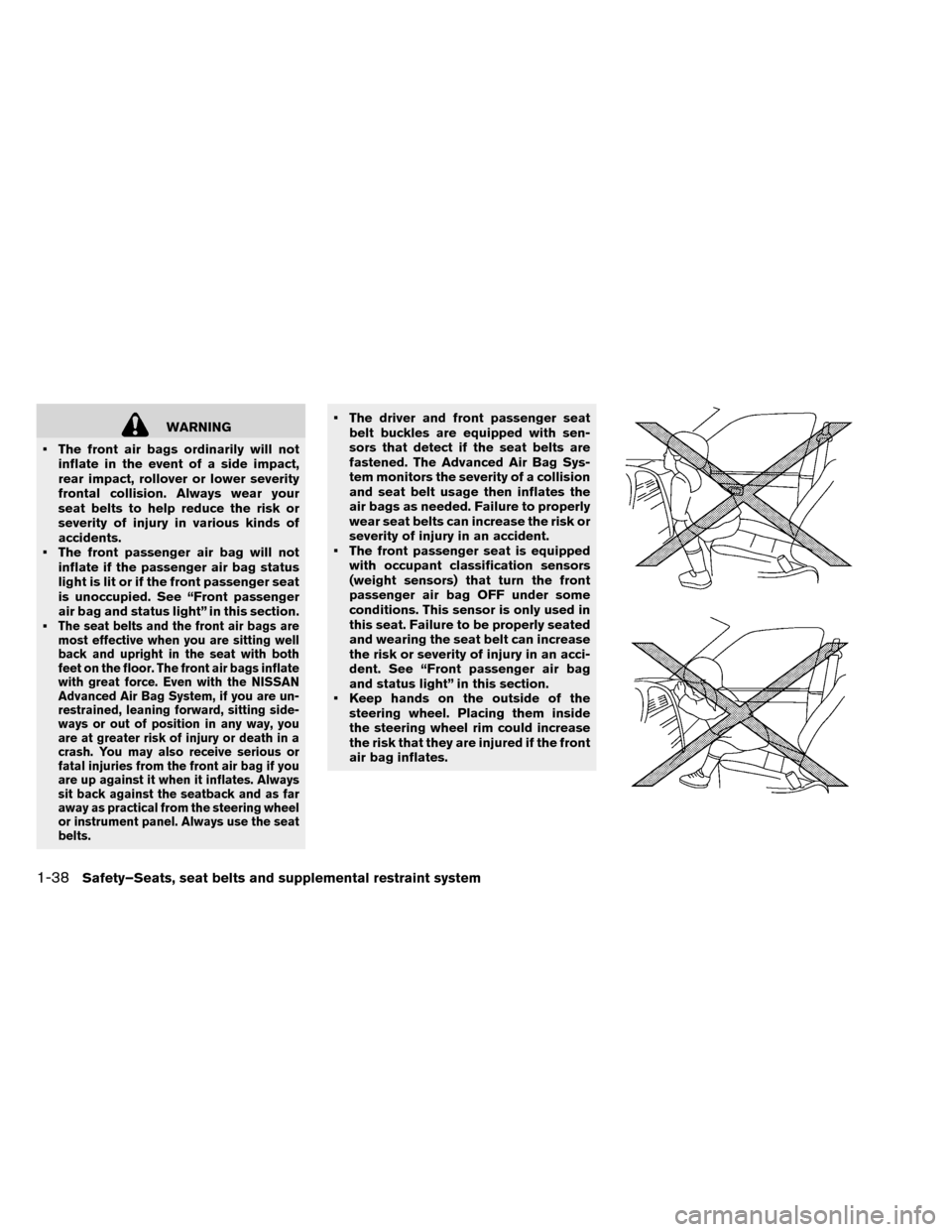
WARNING
• The front air bags ordinarily will not inflate in the event of a side impact,
rear impact, rollover or lower severity
frontal collision. Always wear your
seat belts to help reduce the risk or
severity of injury in various kinds of
accidents.
• The front passenger air bag will not inflate if the passenger air bag status
light is lit or if the front passenger seat
is unoccupied. See “Front passenger
air bag and status light” in this section.
•
The seat belts and the front air bags are
most effective when you are sitting well
back and upright in the seat with both
feet on the floor. The front air bags inflate
with great force. Even with the NISSAN
Advanced Air Bag System, if you are un-
restrained, leaning forward, sitting side-
ways or out of position in any way, you
are at greater risk of injury or death in a
crash. You may also receive serious or
fatal injuries from the front air bag if you
are up against it when it inflates. Always
sit back against the seatback and as far
away as practical from the steering wheel
or instrument panel. Always use the seat
belts.
• The driver and front passenger seat belt buckles are equipped with sen-
sors that detect if the seat belts are
fastened. The Advanced Air Bag Sys-
tem monitors the severity of a collision
and seat belt usage then inflates the
air bags as needed. Failure to properly
wear seat belts can increase the risk or
severity of injury in an accident.
• The front passenger seat is equipped with occupant classification sensors
(weight sensors) that turn the front
passenger air bag OFF under some
conditions. This sensor is only used in
this seat. Failure to be properly seated
and wearing the seat belt can increase
the risk or severity of injury in an acci-
dent. See “Front passenger air bag
and status light” in this section.
• Keep hands on the outside of the steering wheel. Placing them inside
the steering wheel rim could increase
the risk that they are injured if the front
air bag inflates.
1-38Safety–Seats, seat belts and supplemental restraint system
Page 126 of 412
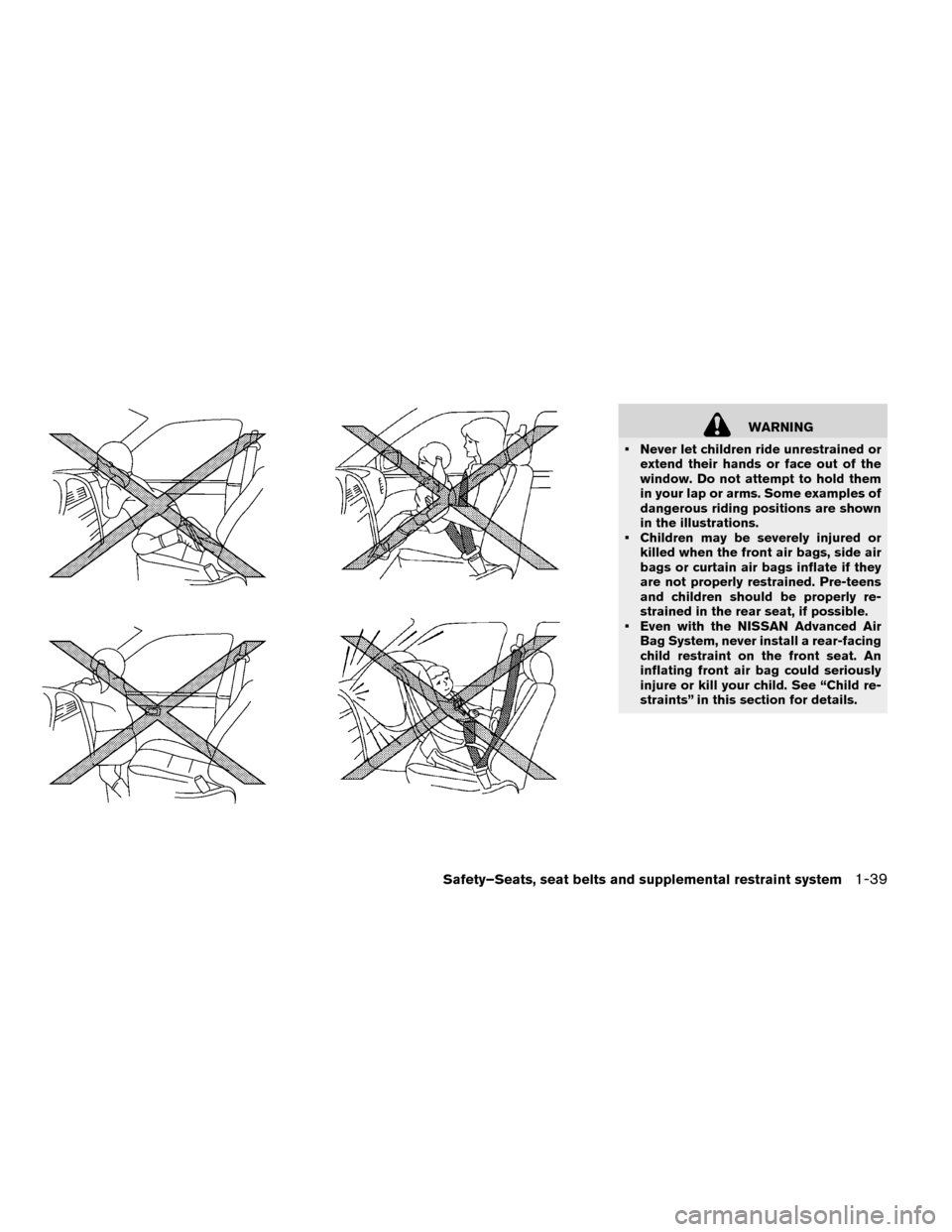
WARNING
• Never let children ride unrestrained or extend their hands or face out of the
window. Do not attempt to hold them
in your lap or arms. Some examples of
dangerous riding positions are shown
in the illustrations.
• Children may be severely injured or killed when the front air bags, side air
bags or curtain air bags inflate if they
are not properly restrained. Pre-teens
and children should be properly re-
strained in the rear seat, if possible.
• Even with the NISSAN Advanced Air Bag System, never install a rear-facing
child restraint on the front seat. An
inflating front air bag could seriously
injure or kill your child. See “Child re-
straints” in this section for details.
Safety–Seats, seat belts and supplemental restraint system1-39
Page 127 of 412
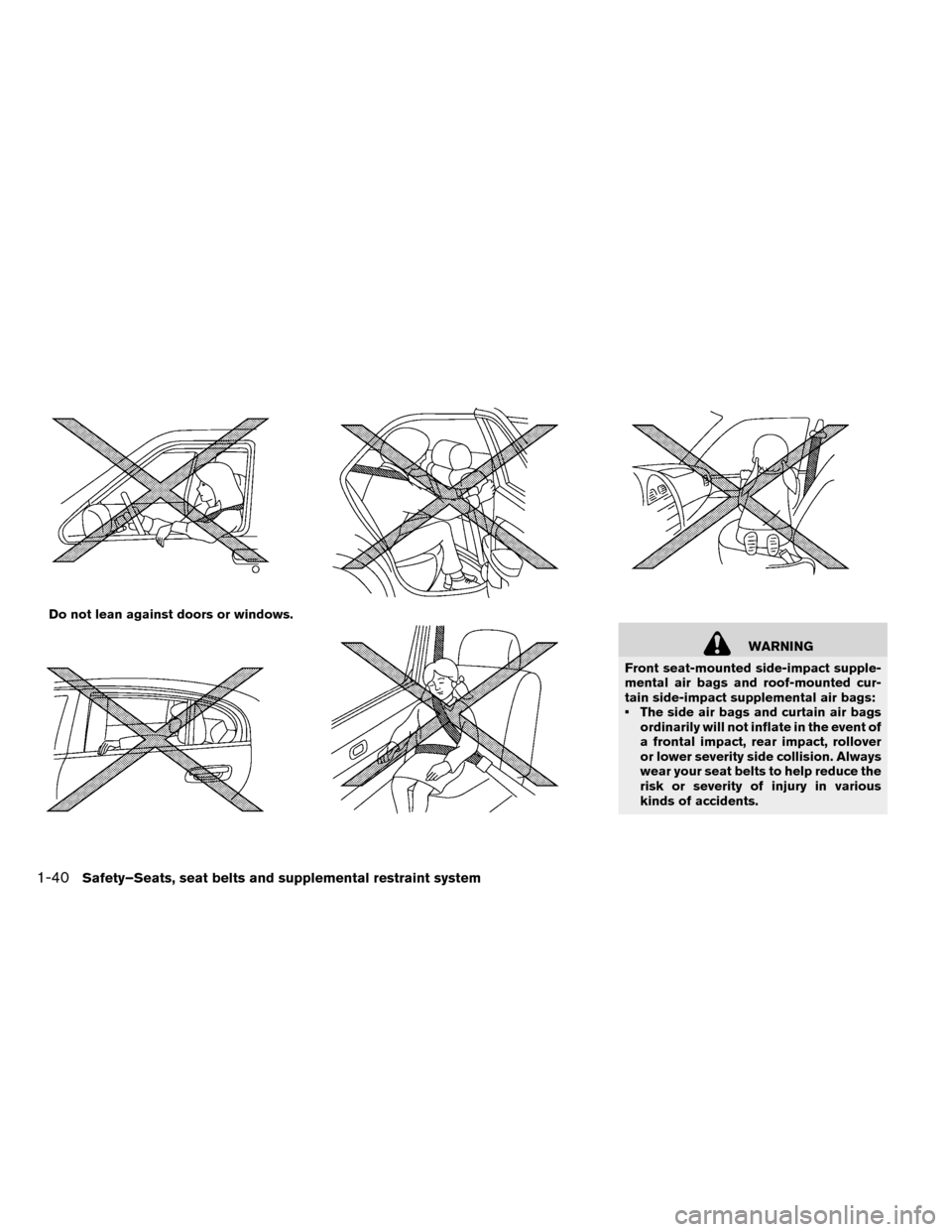
WARNING
Front seat-mounted side-impact supple-
mental air bags and roof-mounted cur-
tain side-impact supplemental air bags:
• The side air bags and curtain air bags ordinarily will not inflate in the event of
a frontal impact, rear impact, rollover
or lower severity side collision. Always
wear your seat belts to help reduce the
risk or severity of injury in various
kinds of accidents.
Do not lean against doors or windows.
1-40Safety–Seats, seat belts and supplemental restraint system
Page 128 of 412

• The seat belts, the side air bags andcurtain air bags are most effective
when you are sitting well back and
upright in the seat. The side air bag
and curtain air bag inflate with great
force. Do not allow anyone to place
their hand, leg or face near the side air
bag on the side of the seatback of the
front seat or near the side roof rails. Do
not allow anyone sitting in the front
seats or rear outboard seats to extend
their hand out of the window or lean
against the door. Some examples of
dangerous riding positions are shown
in the previous illustrations.
• When sitting in the rear seat, do not hold onto the seatback of the front
seat. If the side air bag inflates, you
may be seriously injured. Be especially
careful with children, who should al-
ways be properly restrained. Some ex-
amples of dangerous riding positions
are shown in the illustrations.
• Do not use seat covers on the front seatbacks. They may interfere with
side air bag inflation.
Safety–Seats, seat belts and supplemental restraint system1-41
Page 129 of 412
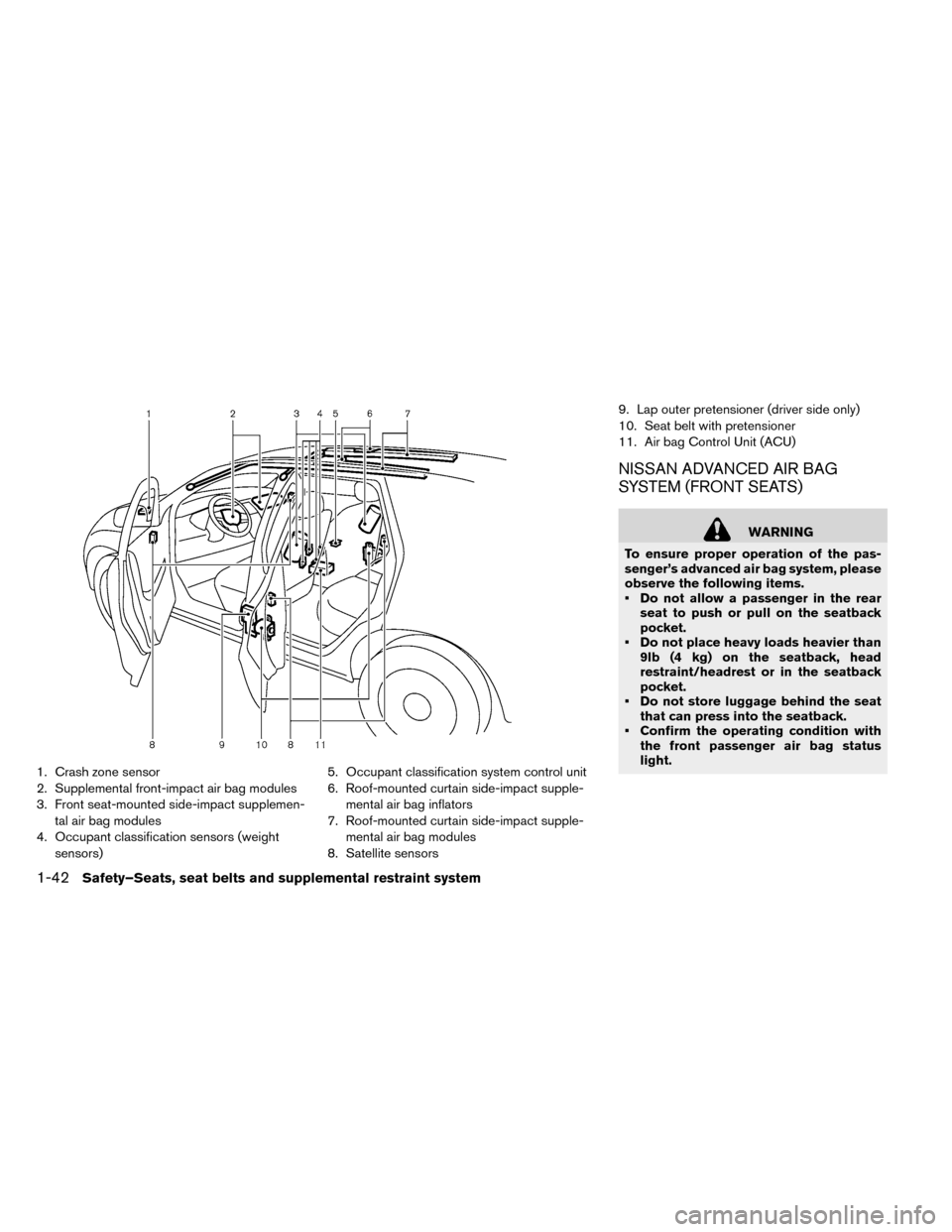
1. Crash zone sensor
2. Supplemental front-impact air bag modules
3. Front seat-mounted side-impact supplemen-tal air bag modules
4. Occupant classification sensors (weight sensors) 5. Occupant classification system control unit
6. Roof-mounted curtain side-impact supple-
mental air bag inflators
7. Roof-mounted curtain side-impact supple- mental air bag modules
8. Satellite sensors 9. Lap outer pretensioner (driver side only)
10. Seat belt with pretensioner
11. Air bag Control Unit (ACU)
NISSAN ADVANCED AIR BAG
SYSTEM (FRONT SEATS)
WARNING
To ensure proper operation of the pas-
senger’s advanced air bag system, please
observe the following items.
• Do not allow a passenger in the rear seat to push or pull on the seatback
pocket.
• Do not place heavy loads heavier than 9lb (4 kg) on the seatback, head
restraint/headrest or in the seatback
pocket.
• Do not store luggage behind the seat that can press into the seatback.
• Confirm the operating condition with the front passenger air bag status
light.
1-42Safety–Seats, seat belts and supplemental restraint system
Page 130 of 412

• If you notice that the front passengerair bag status light is not operating as
described in this section, please take
your vehicle to your NISSAN certified
LEAF dealer to check the occupant
classification system.
• Until you have confirmed with your dealer that your passenger seat occu-
pant classification system is working
properly, position the occupants in the
rear seating positions.
This vehicle is equipped with the NISSAN Ad-
vanced Air Bag System for the driver and front
passenger seats. This system is designed to
meet certification requirements under U.S. regu-
lations. It is also permitted in Canada. All of the
information, cautions and warnings in this
manual apply and must be followed.
The driver supplemental front-impact air bag is
located in the center of the steering wheel. The
passenger supplemental front-impact air bag is
mounted in the instrument panel above the glove
box. The front air bags are designed to inflate in
higher severity frontal collisions, although they
may inflate if the forces in another type of collision
are similar to those of a higher severity frontal
impact. They may not inflate in certain frontal
collisions. Vehicle damage (or lack of it) is not always an indication of proper front air bag op-
eration.
The NISSAN Advanced Air Bag System has dual
stage air bag inflators. The system monitors infor-
mation from the Air bag Control Unit (ACU) , seat
belt buckle sensors and the occupant classifica-
tion sensors (weight sensors) . Inflator operation
is based on the severity of a collision and seat
belt usage for the driver. For the front passenger,
the occupant classification sensors are also
monitored. Based on information from the sen-
sors, only one front air bag may inflate in a crash,
depending on the crash severity and whether the
front occupants are belted or unbelted. Addition-
ally, the front passenger air bag may be automati-
cally turned OFF under some conditions, de-
pending on the information provided by the
occupant classification sensors. If the front pas-
senger air bag is OFF, the passenger air bag
status light will be illuminated (if the seat is unoc-
cupied, the light will not be illuminated, but the air
bag will be off) . See “Front passenger air bag and
status light” in this section for further details. One
front air bag inflating does not indicate improper
performance of the system.
If you have any questions about your air bag
system, contact NISSAN or a NISSAN certified
LEAF dealer. If you are considering modification
of your vehicle due to a disability, you may also
contact NISSAN. Contact information is con-
tained in the front of this Owner’s Manual.
When a front air bag inflates, a fairly loud noise
may be heard, followed by release of smoke. This
smoke is not harmful and does not indicate a fire.
Care should be taken not to inhale it, as it may
cause irritation and choking. Those with a history
of a breathing condition should get fresh air
promptly.
Front air bags, along with the use of seat belts,
help to cushion the impact force on the head and
chest of the front occupants. They can help save
lives and reduce serious injuries. However, an
inflating front air bag may cause facial abrasions
or other injuries. Front air bags do not provide
restraint to the lower body.
Even with NISSAN Advanced Air Bags, seat
belts should be correctly worn and the driver and
passenger seated upright as far as practical
away from the steering wheel or instrument
panel. The front air bags inflate quickly in order to
help protect the front occupants. Because of this,
the force of the front air bag inflating can increase
the risk of injury if the occupant is too close to, or
is against, the air bag module during inflation.
Safety–Seats, seat belts and supplemental restraint system1-43
Page 131 of 412
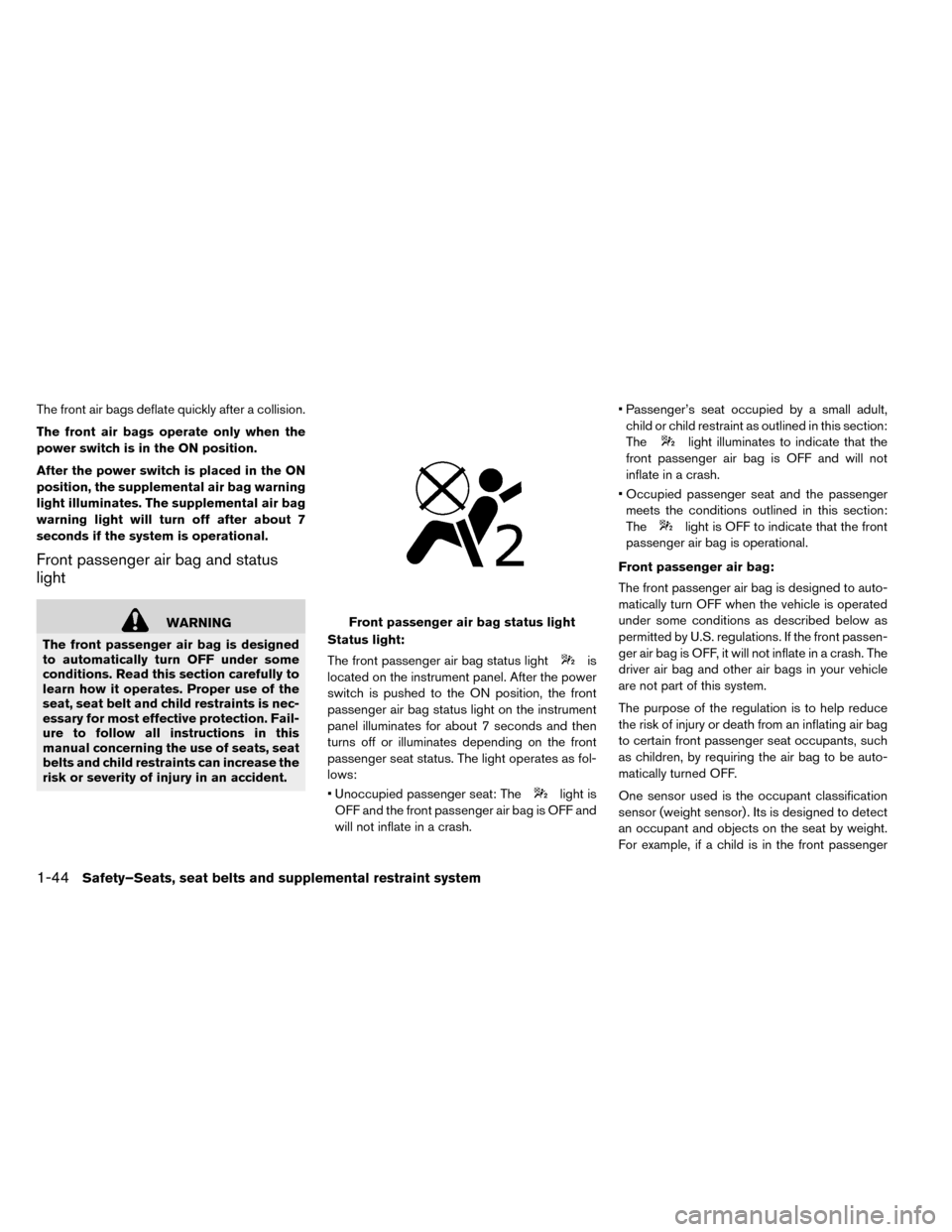
The front air bags deflate quickly after a collision.
The front air bags operate only when the
power switch is in the ON position.
After the power switch is placed in the ON
position, the supplemental air bag warning
light illuminates. The supplemental air bag
warning light will turn off after about 7
seconds if the system is operational.
Front passenger air bag and status
light
WARNING
The front passenger air bag is designed
to automatically turn OFF under some
conditions. Read this section carefully to
learn how it operates. Proper use of the
seat, seat belt and child restraints is nec-
essary for most effective protection. Fail-
ure to follow all instructions in this
manual concerning the use of seats, seat
belts and child restraints can increase the
risk or severity of injury in an accident. Status light:
The front passenger air bag status light
is
located on the instrument panel. After the power
switch is pushed to the ON position, the front
passenger air bag status light on the instrument
panel illuminates for about 7 seconds and then
turns off or illuminates depending on the front
passenger seat status. The light operates as fol-
lows:
• Unoccupied passenger seat: The
light is
OFF and the front passenger air bag is OFF and
will not inflate in a crash. • Passenger’s seat occupied by a small adult,
child or child restraint as outlined in this section:
The
light illuminates to indicate that the
front passenger air bag is OFF and will not
inflate in a crash.
• Occupied passenger seat and the passenger meets the conditions outlined in this section:
The
light is OFF to indicate that the front
passenger air bag is operational.
Front passenger air bag:
The front passenger air bag is designed to auto-
matically turn OFF when the vehicle is operated
under some conditions as described below as
permitted by U.S. regulations. If the front passen-
ger air bag is OFF, it will not inflate in a crash. The
driver air bag and other air bags in your vehicle
are not part of this system.
The purpose of the regulation is to help reduce
the risk of injury or death from an inflating air bag
to certain front passenger seat occupants, such
as children, by requiring the air bag to be auto-
matically turned OFF.
One sensor used is the occupant classification
sensor (weight sensor) . Its is designed to detect
an occupant and objects on the seat by weight.
For example, if a child is in the front passenger
Front passenger air bag status light
1-44Safety–Seats, seat belts and supplemental restraint system
Page 132 of 412
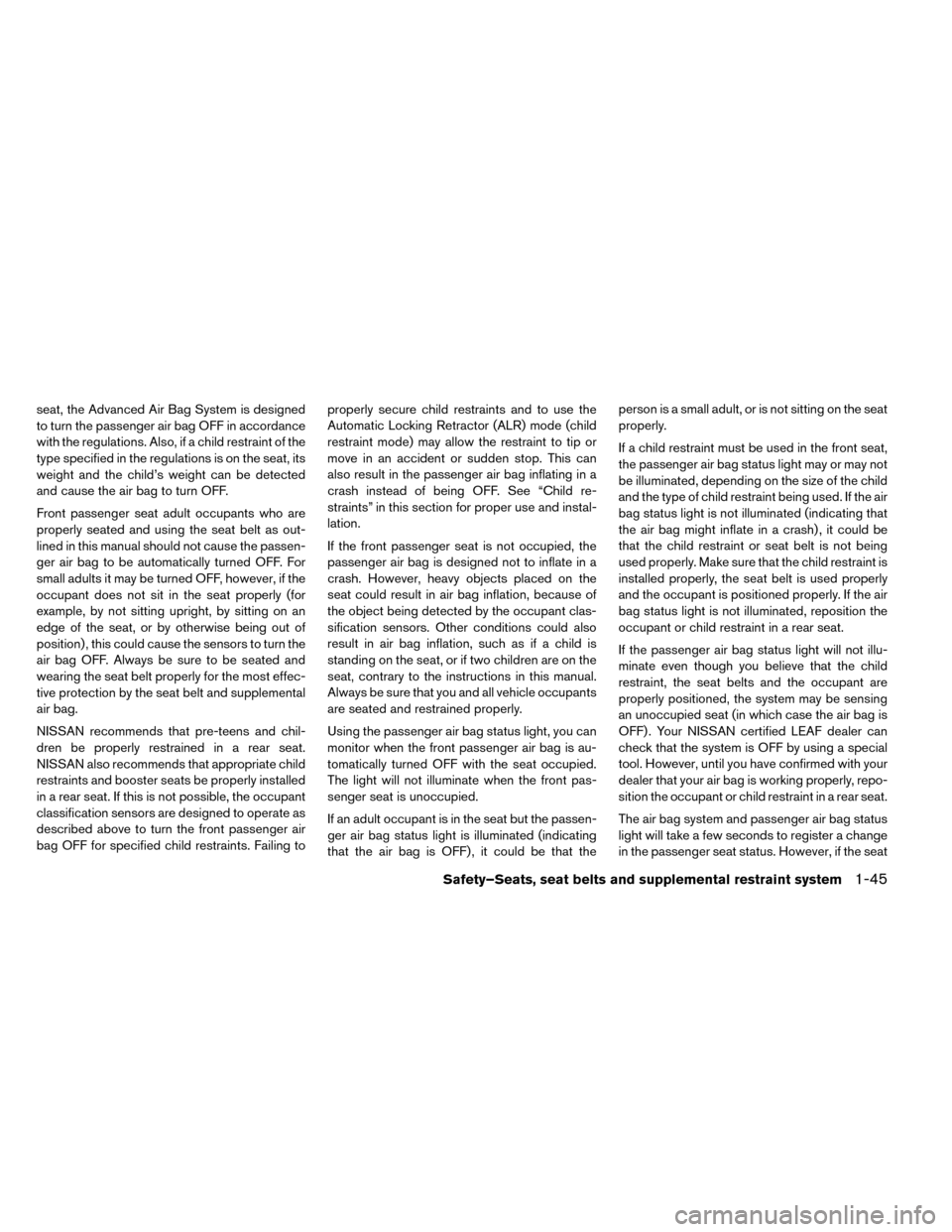
seat, the Advanced Air Bag System is designed
to turn the passenger air bag OFF in accordance
with the regulations. Also, if a child restraint of the
type specified in the regulations is on the seat, its
weight and the child’s weight can be detected
and cause the air bag to turn OFF.
Front passenger seat adult occupants who are
properly seated and using the seat belt as out-
lined in this manual should not cause the passen-
ger air bag to be automatically turned OFF. For
small adults it may be turned OFF, however, if the
occupant does not sit in the seat properly (for
example, by not sitting upright, by sitting on an
edge of the seat, or by otherwise being out of
position) , this could cause the sensors to turn the
air bag OFF. Always be sure to be seated and
wearing the seat belt properly for the most effec-
tive protection by the seat belt and supplemental
air bag.
NISSAN recommends that pre-teens and chil-
dren be properly restrained in a rear seat.
NISSAN also recommends that appropriate child
restraints and booster seats be properly installed
in a rear seat. If this is not possible, the occupant
classification sensors are designed to operate as
described above to turn the front passenger air
bag OFF for specified child restraints. Failing toproperly secure child restraints and to use the
Automatic Locking Retractor (ALR) mode (child
restraint mode) may allow the restraint to tip or
move in an accident or sudden stop. This can
also result in the passenger air bag inflating in a
crash instead of being OFF. See “Child re-
straints” in this section for proper use and instal-
lation.
If the front passenger seat is not occupied, the
passenger air bag is designed not to inflate in a
crash. However, heavy objects placed on the
seat could result in air bag inflation, because of
the object being detected by the occupant clas-
sification sensors. Other conditions could also
result in air bag inflation, such as if a child is
standing on the seat, or if two children are on the
seat, contrary to the instructions in this manual.
Always be sure that you and all vehicle occupants
are seated and restrained properly.
Using the passenger air bag status light, you can
monitor when the front passenger air bag is au-
tomatically turned OFF with the seat occupied.
The light will not illuminate when the front pas-
senger seat is unoccupied.
If an adult occupant is in the seat but the passen-
ger air bag status light is illuminated (indicating
that the air bag is OFF) , it could be that theperson is a small adult, or is not sitting on the seat
properly.
If a child restraint must be used in the front seat,
the passenger air bag status light may or may not
be illuminated, depending on the size of the child
and the type of child restraint being used. If the air
bag status light is not illuminated (indicating that
the air bag might inflate in a crash) , it could be
that the child restraint or seat belt is not being
used properly. Make sure that the child restraint is
installed properly, the seat belt is used properly
and the occupant is positioned properly. If the air
bag status light is not illuminated, reposition the
occupant or child restraint in a rear seat.
If the passenger air bag status light will not illu-
minate even though you believe that the child
restraint, the seat belts and the occupant are
properly positioned, the system may be sensing
an unoccupied seat (in which case the air bag is
OFF) . Your NISSAN certified LEAF dealer can
check that the system is OFF by using a special
tool. However, until you have confirmed with your
dealer that your air bag is working properly, repo-
sition the occupant or child restraint in a rear seat.
The air bag system and passenger air bag status
light will take a few seconds to register a change
in the passenger seat status. However, if the seat
Safety–Seats, seat belts and supplemental restraint system1-45